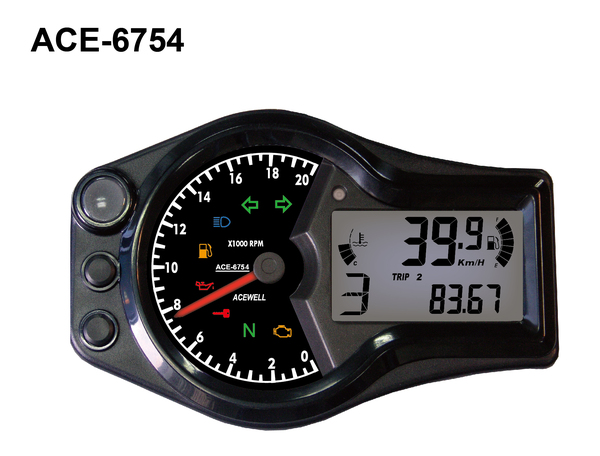The Advantages of Setting Up a Tachometer in Your Lorry
The Advantages of Setting Up a Tachometer in Your Lorry
Blog Article
The Relevance of a Tachometer in Monitoring Engine Rate and Performance in Automotive Applications
In the world of vehicle engineering, the tachometer stands as a crucial tool in the driver's toolbox, offering a straight window right into the inner operations of an automobile's engine. Beyond its function as a plain gauge of changes per minute (RPM), the tachometer serves as a crucial device for lovers and specialists alike, using real-time insights right into engine performance and health and wellness. Understanding the importance of this tool goes beyond surface-level observations, delving right into the elaborate connection in between engine rate, power result, and overall driving experience. As we explore the diverse function of the tachometer in vehicle applications, a much deeper admiration for its influence on lorry dynamics and efficiency begins to arise.
Relevance of Monitoring Engine RPM
Monitoring engine RPM, or revolutions per minute, is a critical aspect of automotive maintenance and efficiency evaluation. Engine RPM straight associates with the rate at which the engine's crankshaft turns, showing exactly how swiftly the engine is running - tachometer. By keeping an eye on RPM, auto mechanics can examine the health and wellness of the engine, find prospective problems, and fine-tune performance. An abnormal RPM analysis might signify troubles such as engine misfires, malfunctioning trigger plugs, or problems with the fuel distribution system. Constantly high RPM analyses could indicate hostile driving routines or the requirement for a higher equipment shift to improve gas effectiveness.
Furthermore, checking engine RPM is necessary for performance analysis in auto racing and high-performance vehicles. Keeping optimal RPM degrees is vital for achieving peak power result and acceleration. Racers usually utilize tachometers to ensure they are operating within the ideal RPM variety for optimum performance. In recap, keeping track of engine RPM is not just vital for detecting issues but also for enhancing engine performance in numerous auto applications.

Advantages of Real-Time Data
In automobile applications, real-time data plays a critical duty in providing instant insights into the performance and condition of the vehicle. By continuously keeping track of different specifications such as engine rate, temperature, fuel usage, and much more, real-time data provides various benefits that contribute to improved effectiveness and security when traveling.
One significant advantage of real-time information is its capacity to sharp vehicle drivers and technicians to any kind of abnormalities or concerns immediately. This positive technique makes it possible for fast recognition of prospective issues, enabling for timely interventions to avoid more damages or break downs. Additionally, real-time information promotes efficiency optimization by supplying instant feedback on driving habits and engine performance. Vehicle drivers can change their habits in real-time based on this details to accomplish better gas economic situation and extend the lifespan of their automobile.

Furthermore, real-time information plays a crucial role in modern-day automobile diagnostics, enabling professionals to promptly identify and address breakdowns. This results in lowered downtime, lower upkeep costs, and eventually, improved overall automobile reliability and longevity (tachometer). By taking advantage of the power of real-time information, automotive stakeholders can make enlightened decisions that favorably affect both the efficiency and longevity of the vehicle
Influence on Equipment Shifts
The tachometer plays a crucial duty in optimizing equipment changes by giving real-time engine rate information to the vehicle driver. When coming close to the redline on the tachometer, it indicates the motorist to upshift to stop over-revving the engine and triggering prospective damage.
Furthermore, the tachometer help in attaining smoother equipment shifts, particularly in manual transmissions. By keeping track of engine speed, drivers can implement equipment changes anchor at the ideal RPM range, reducing snagging activities and lessening wear on the transmission components. This accuracy in equipment changes not just boosts driving comfort but additionally adds to fuel efficiency.
Enhancing Gas Effectiveness
Given the critical duty the tachometer plays in enhancing gear changes for performance and engine wellness, it straight contributes to optimizing fuel performance in vehicle applications. By offering real-time responses on engine rate, the tachometer assists vehicle drivers in preserving one basics of the most effective RPM range for gas economic climate. When drivers consistently check the tachometer and change their motoring routines accordingly, they can prevent unneeded fuel intake triggered by over-revving or lugging the engine.
In addition, the tachometer helps vehicle drivers determine the most fuel-efficient equipment to be in at any kind of given moment, stopping the engine from working tougher than necessary. This is specifically critical throughout acceleration and cruising, where being in the best equipment can significantly influence fuel effectiveness. In addition, the tachometer can alert chauffeurs to possible mechanical issues that could be negatively influencing gas economy, such as a slipping clutch or a stopped up air filter. To conclude, the tachometer functions as an important device in boosting gas efficiency by promoting optimal driving practices and determining locations for renovation in the vehicle's performance.

Optimizing Engine Durability
The tachometer's role in checking engine speed and performance is crucial in guaranteeing the long life of automobile engines. Monitoring the tachometer enables drivers to remain within the recommended RPM variety for their vehicle, stopping unneeded stress on the engine and expanding its life expectancy.

Verdict
Finally, the tachometer plays an essential role in keeping an eye on engine speed and performance in automobile applications. By supplying real-time data on RPM, it permits effective gear changes, improved gas performance, and taken full advantage of engine long life. This device is essential for maintaining optimum engine efficiency and guaranteeing the overall capability of a vehicle.
Report this page